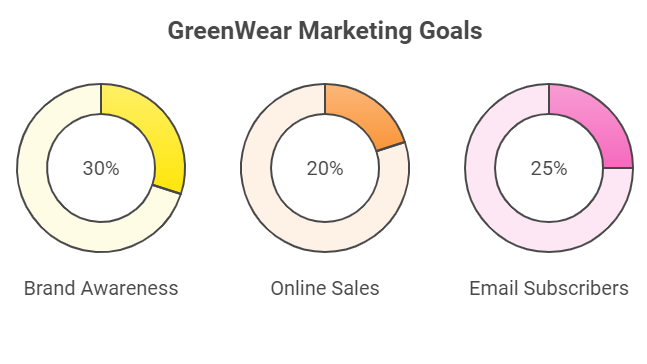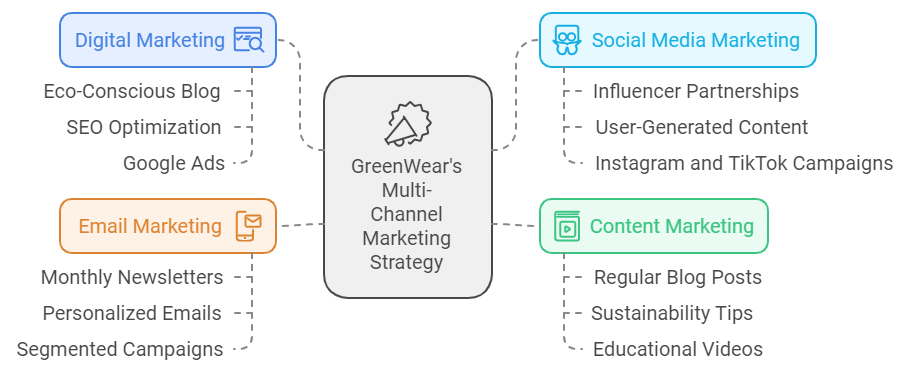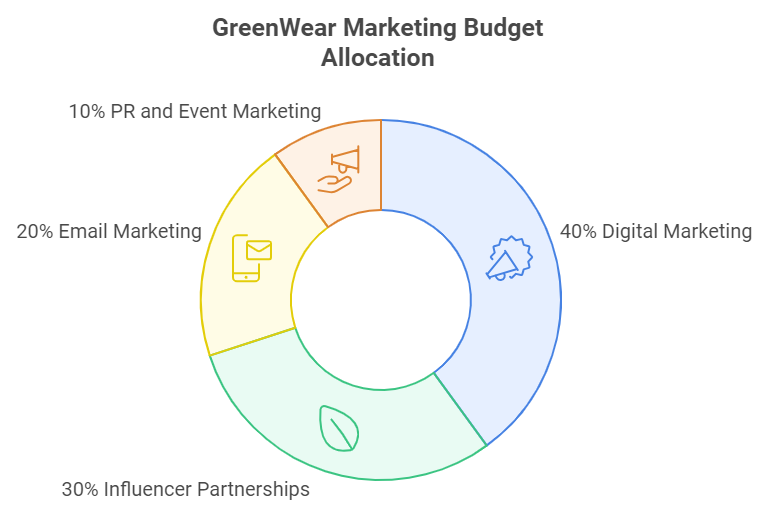Introduction
Marketing Plan Example – A marketing plan is a strategic document that outlines a business’s marketing objectives and the tactics needed to achieve them. It provides a clear roadmap for reaching target audiences, promoting products or services, and driving business growth. A well-crafted marketing plan not only aligns marketing efforts with business goals but also helps in maximizing return on investment (ROI) by focusing on the most effective channels and strategies.
In this article, we will walk through a detailed marketing plan example for a fictional business, an eco-friendly apparel brand called GreenWear. This example will provide readers with a practical guide they can use to develop their own marketing strategies. By examining each key section of the marketing plan, from the business overview to market analysis, readers will gain valuable insights into how to create a successful and sustainable marketing strategy.
Business Overview (Example: Eco-Friendly Apparel Brand)
GreenWear is an eco-friendly apparel brand dedicated to providing stylish, sustainable clothing while minimizing environmental impact. The company’s mission is to offer high-quality, fashionable clothing that is ethically produced using environmentally friendly materials and processes. Through transparency and sustainable practices, GreenWear aims to inspire conscious consumerism and reduce the carbon footprint of fashion.
The company’s vision is to become a leader in eco-conscious fashion by making sustainable clothing accessible and appealing to a wide range of customers. GreenWear believes in promoting transparency throughout its supply chain, ensuring that all materials are ethically sourced and that production processes minimize waste and pollution. These core values—sustainability, ethics, and transparency—form the foundation of GreenWear’s marketing strategy and influence all aspects of its branding and customer messaging.
By prioritizing sustainability and ethical practices, GreenWear differentiates itself from traditional fashion brands that often rely on fast fashion and environmentally harmful production processes. This commitment to eco-friendly practices is reflected in the brand’s products, packaging, and marketing efforts, which aim to appeal to environmentally conscious consumers.
Market Analysis (Example)
To build a successful marketing plan, GreenWear begins with a thorough market analysis to understand the industry landscape, target audience, and competition.
Industry Trends:
GreenWear operates in the growing sustainable fashion industry, which has seen a surge in demand as consumers become more environmentally aware. Recent trends indicate that millennials and Gen Z are increasingly prioritizing sustainability when making purchasing decisions. These younger generations value eco-conscious brands that align with their ethical and environmental values. Additionally, there is a rising trend toward slow fashion, where consumers seek durable, high-quality clothing that has a longer life cycle, as opposed to fast fashion, which contributes to environmental degradation.
Customer Demographics:
GreenWear’s target audience primarily consists of millennials and Gen Z consumers, aged 18-35, who are socially conscious and environmentally aware. These consumers are active on social media, highly informed about sustainability issues, and willing to pay a premium for ethically produced products. They are also likely to be urban dwellers who value style as much as sustainability, making GreenWear’s products a perfect fit for their lifestyle.
Competitive Analysis:
In the competitive landscape, GreenWear faces competition from both large established brands offering eco-friendly product lines and smaller niche brands specializing in sustainable fashion. While brands like Patagonia and Everlane have carved out significant market share with their eco-conscious offerings, GreenWear differentiates itself by providing affordable, stylish apparel that balances sustainability with trend-forward designs.
Unlike many competitors that focus on higher-end price points, GreenWear aims to make sustainable fashion more accessible by offering competitively priced products without sacrificing ethical production practices. The company’s focus on affordability and style, combined with a strong commitment to sustainability, gives it a unique position in the market. Additionally, GreenWear capitalizes on its transparency by sharing its supply chain practices with consumers, building trust and loyalty.
This market analysis provides GreenWear with valuable insights that will guide the development of its marketing strategy. By understanding the needs of its target audience and identifying key opportunities within the industry, GreenWear can craft a marketing plan that addresses current trends and sets the brand apart from competitors.
Define Marketing Goals (Example)

For GreenWear, setting clear and measurable marketing goals is essential to guide its efforts and track success. These goals are aligned with the company’s overall business objectives and reflect its desire to increase brand visibility, drive sales, and grow customer engagement. Using the SMART framework (Specific, Measurable, Achievable, Relevant, Time-bound), GreenWear has established the following key marketing goals:
- Increase Brand Awareness by 30% in Six Months: To achieve this, GreenWear plans to run targeted social media campaigns and partner with influencers who share the brand’s eco-friendly values. The goal is to expand the brand’s reach by growing its social media following and increasing engagement on platforms like Instagram and TikTok, where its target audience is most active.
- Boost Online Sales by 20% in the Next Quarter: GreenWear aims to increase e-commerce sales by launching new product lines, such as limited-edition sustainable clothing collections. In addition, the company will offer time-sensitive promotions and discounts to encourage customers to make purchases during specific promotional periods.
- Build a Loyal Customer Base by Increasing Email Subscribers by 25% in Six Months: GreenWear wants to grow its email list to foster long-term relationships with customers. The company plans to offer incentives such as exclusive discounts and early access to new collections to encourage sign-ups.
These marketing goals are clear, measurable, and aligned with GreenWear’s mission to grow both its brand presence and its revenue while staying true to its eco-conscious principles.
Develop the Marketing Strategy (Example)

To achieve its marketing goals, GreenWear will implement a multi-channel marketing strategy that leverages digital platforms and content to engage with its target audience. The strategy will focus on the following tactics:
- Digital Marketing:
GreenWear will create an eco-conscious blog on its website, focusing on sustainability in fashion, ethical production practices, and environmental impact. By optimizing blog content for search engines (SEO), GreenWear will drive organic traffic to its site, positioning the brand as a thought leader in the eco-friendly apparel space. Additionally, the company will use Google Ads to capture search intent from users looking for sustainable clothing options. - Social Media Marketing:
GreenWear will partner with influencers who resonate with its eco-friendly values. These influencers will create content showcasing GreenWear products, focusing on how the brand’s clothing supports a sustainable lifestyle. The campaigns will run on platforms like Instagram and TikTok, with a goal of increasing followers, engagement, and brand visibility among millennial and Gen Z audiences. User-generated content will also be encouraged to enhance brand authenticity. - Content Marketing:
GreenWear will publish regular content on its blog and social media channels, including sustainability tips, behind-the-scenes stories about ethical production, and product features. This content will highlight the brand’s commitment to transparency and eco-friendly practices, strengthening the emotional connection with its audience. The brand will also create educational video content explaining the importance of sustainable fashion and how its products contribute to a greener planet. - Email Marketing:
Monthly newsletters will be sent to GreenWear’s growing email list, featuring exclusive content, product launches, and special offers. Emails will be personalized based on customer behavior (e.g., browsing history, previous purchases) to encourage repeat purchases and build long-term customer relationships. A key tactic will be using segmented email campaigns to target specific customer groups with tailored promotions.
Each of these strategies will work together to build awareness, drive traffic, and increase sales, while maintaining a focus on GreenWear’s eco-conscious brand messaging.
Budgeting and Resource Allocation (Example)

For GreenWear to execute its marketing strategy effectively, it needs to allocate its resources efficiently across the different tactics and channels. Here’s how GreenWear plans to distribute its marketing budget:
- 40% to Digital Marketing:
This includes spending on SEO (both for blog content and website optimization), Google Ads, and social media advertising. By focusing on digital marketing, GreenWear will capture both organic and paid traffic, which is essential for expanding brand reach and driving e-commerce sales. - 30% to Influencer Partnerships:
A significant portion of the budget will go toward collaborations with influencers who align with the brand’s eco-friendly values. These partnerships will involve sponsored content, giveaways, and product placements, all aimed at increasing brand awareness and engagement. Influencer marketing has proven to be particularly effective for lifestyle and fashion brands targeting younger demographics. - 20% to Email Marketing:
This part of the budget will cover email platform subscriptions, campaign management, and personalized content creation. Since email marketing offers one of the highest ROIs in digital marketing, GreenWear plans to invest in building a highly targeted email list and creating engaging, conversion-driven campaigns. - 10% to PR and Event Marketing:
The remaining budget will go toward public relations initiatives and event sponsorships. This will include hosting eco-friendly fashion events and participating in sustainability-focused expos to further establish GreenWear as a leader in the eco-conscious fashion space. The brand will also explore partnerships with like-minded companies to cross-promote and expand its audience reach.
By prioritizing spending on channels that offer the best opportunities for growth—digital marketing and influencer partnerships—GreenWear ensures that its marketing efforts are both efficient and impactful. This resource allocation strategy allows GreenWear to maintain flexibility, monitor results, and adjust spending as necessary to optimize performance.
Monitor and Measure Results
Monitoring and measuring the effectiveness of a marketing plan is crucial to ensuring that it delivers on the goals set at the outset. By tracking key performance indicators (KPIs), GreenWear can determine which strategies are working and where adjustments are needed to optimize performance.
KPIs to Track:
- Website Traffic and Conversion Rates: Using tools like Google Analytics, GreenWear can monitor traffic to its website, blog, and product pages. Important metrics include page views, session duration, bounce rate, and, most critically, conversion rates (the percentage of visitors who make a purchase). This data provides insight into which marketing activities are driving traffic and which channels are converting visitors into customers.
- Social Media Engagement: Social media insights on platforms like Instagram and TikTok will allow GreenWear to measure engagement metrics such as likes, shares, comments, and follower growth. These metrics help gauge the success of influencer partnerships, user-generated content, and ad campaigns. Higher engagement often signals stronger brand awareness and customer interest.
- Email Campaign Performance: For email marketing, KPIs like open rates, click-through rates (CTR), and conversion rates will be tracked. These metrics indicate how well GreenWear’s email content resonates with its audience and how effective email campaigns are in driving sales.
- Return on Investment (ROI): Overall ROI will be a key measure of success, particularly when it comes to paid campaigns like social media ads and influencer collaborations. Calculating ROI will help determine whether the marketing spend is generating sufficient revenue to justify continued investment.
Adjusting the Strategy: Based on these insights, GreenWear can continuously refine its marketing efforts. For instance, if social media engagement is higher than anticipated, GreenWear might choose to allocate additional budget to influencer partnerships. Conversely, if email campaigns are underperforming, the company might experiment with different content types or more personalized messaging to increase engagement.
By reviewing these metrics regularly (e.g., monthly or quarterly), GreenWear ensures that its marketing plan remains dynamic and responsive to changing market conditions. This data-driven approach allows the company to capitalize on successful tactics, optimize underperforming areas, and stay aligned with its broader business objectives.
Conclusion
The GreenWear marketing plan example illustrates a flexible framework that any business can follow to build a successful strategy. By following the six steps—defining the business overview, conducting a market analysis, setting SMART goals, developing a marketing strategy, allocating resources, and monitoring results—businesses can create a strategic marketing plan that drives growth and success.
For businesses looking to get started, Sheaf Media offers a free marketing plan to help companies lay the groundwork for their marketing efforts. This free marketing plan serves as a valuable resource for developing a customized, actionable strategy aligned with business goals.
It’s important to remember that a strategic marketing plan is a living document that must evolve over time. By regularly reviewing performance and staying adaptable to market changes, businesses can optimize their strategies and ensure continued growth. Whether using this marketing plan example as a guide or leveraging Sheaf Media’s free marketing plan, companies can effectively align their marketing efforts with long-term objectives, ensuring measurable success in today’s competitive landscape.

Juan is a Digital Advertising / SEM Specialist with over 10 years of experience with Google AdWords, Bing Ad Center, Facebook, LinkedIn, Google Analytics, HTML, and WordPress. He is a co-founder of Sheaf Media Group and has work in several online advertising projects for retail, automotive, and service industries. Additionally, Juan holds a bachelor’s degree in Psychology and has a deep interest in the science of human behavior which he attributes as the key factor for his success in the advertising world.


